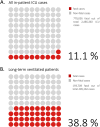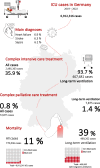Analyzing the use of specialized palliative care in intensive care unit patients in Germany: a cross-sectional study
- PMID: 40114097
- PMCID: PMC11924865
- DOI: 10.1186/s12904-025-01718-1
Analyzing the use of specialized palliative care in intensive care unit patients in Germany: a cross-sectional study
Abstract
Background: Despite rising importance of integration of palliative medicine in treating life-threatening illnesses in intensive care units (ICU), the extent remains unknown. Using billing data, we analysed the frequency of specialized palliative care use in ICU patients in Germany.
Methods: Billing data (2019 -2022) from the InEK was used in this cross-sectional study on all billed adult ICU cases. Data included case numbers, demographics, diagnoses, treatment procedures, ventilation (≥ 95 h), palliative care frequency.
Results: 61,591,299 adult cases were treated, 11.2% (6,912,316) requiring ICU and 499,262 (7.2%) needing long-term ventilation. 44.2% of all ICU cases and 36.2% of long-term ventilated patients were female (p < 0.0001). ICU mortality was 11.1%, long-term ventilation mortality was 38.8%; higher in men and patients aged ≥ 65 (p < 0.001). Leading diagnoses for ICU deaths: heart failure (6.9%), stroke (6.3%), sepsis (6.2%). 0.8% of ICU cases and 1.4% of long-term ventilated cases received specialized palliative care, with a higher proportion of females (p < 0.0001). Most palliative care patients were aged ≥ 65.
Conclusion: From 2019 to 2022, 11.2% of hospital cases required ICU-treatment. Despite suffering from life-threatening conditions and high mortality rates, less than 1% of all ICU cases and 1.4% of long-term ventilated cases received palliative care (differing sexes and ages). This highlights deficiencies in palliative care integration into ICUs to alleviate patients and their families suffering from complex needs. Implementing benchmarking could be beneficial in this process.
Keywords: Age; Critical care; Gender; Interdisciplinary research; Long-term ventilation; Mortality; Palliative medicine.
© 2025. The Author(s).
Conflict of interest statement
Declarations. Ethics approval and consent to participate: We exclusively relied on publicly available data, removing the need for individual patient consent. We followed the ethical principles outlined in the 1964 Helsinki Declaration and its later amendments, and all procedures involving human participants in this study were approved by the institutional and local ethics committee (study ID: 190032024-ANF, ethics committee of the Brandenburg Medical School, Germany). Consent for publication: Not applicable. Competing interests: The authors declare no competing interests.
Figures



Similar articles
-
Moral distress, attitude toward death, and palliative care core competencies among ICU nurses: a cross-sectional study.BMC Palliat Care. 2025 Jan 16;24(1):16. doi: 10.1186/s12904-025-01655-z. BMC Palliat Care. 2025. PMID: 39825296 Free PMC article.
-
Preliminary report of the integration of a palliative care team into an intensive care unit.Palliat Med. 2010 Mar;24(2):154-65. doi: 10.1177/0269216309346540. Epub 2009 Oct 13. Palliat Med. 2010. PMID: 19825893
-
Estimates of the need for palliative care consultation across united states intensive care units using a trigger-based model.Am J Respir Crit Care Med. 2014 Feb 15;189(4):428-36. doi: 10.1164/rccm.201307-1229OC. Am J Respir Crit Care Med. 2014. PMID: 24261961 Free PMC article.
-
Critical Care at the End of Life.Semin Respir Crit Care Med. 2015 Dec;36(6):921-33. doi: 10.1055/s-0035-1565254. Epub 2015 Nov 24. Semin Respir Crit Care Med. 2015. PMID: 26600274 Review.
-
Integration of Palliative Care Services in the Intensive Care Unit: A Roadmap for Overcoming Barriers.Clin Chest Med. 2015 Sep;36(3):441-8. doi: 10.1016/j.ccm.2015.05.010. Epub 2015 Jun 27. Clin Chest Med. 2015. PMID: 26304281 Review.
References
-
- Nelson JE, Meier DE, Litke A, Natale DA, Siegel RE, Morrison RS. The symptom burden of chronic critical illness. Crit Care Med. 2004;32(7):1527–34. - PubMed
-
- de Miranda S, Pochard F, Chaize M, Megarbane B, Cuvelier A, Bele N, Gonzalez-Bermejo J, Aboab J, Lautrette A, Lemiale V, et al. Postintensive care unit psychological burden in patients with chronic obstructive pulmonary disease and informal caregivers: A multicenter study. Crit Care Med. 2011;39(1):112–8. - PubMed
-
- Pochard F, Darmon M, Fassier T, Bollaert P-E, Cheval C, Coloigner M, Merouani A, Moulront S, Pigne E, Pingat J, et al. Symptoms of anxiety and depression in family members of intensive care unit patients before discharge or death. A prospective multicenter study. J Crit Care. 2005;20(1):90–6. - PubMed
MeSH terms
LinkOut - more resources
Full Text Sources
Medical

